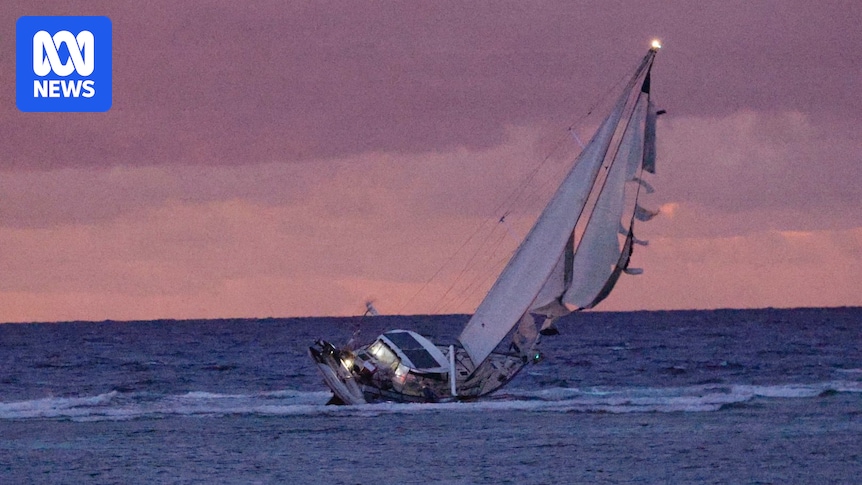The moment before the first pink tendrils of sunlight break the darkness over the Coral Sea is Scott Croxon’s favourite part of the day.
Coffee in hand, this is how he starts each shift running the resort on Lady Elliot Island at the southern end of the Great Barrier Reef.
But on one cool August morning, Mr Croxon’s eyes were caught by some electrical lights in the middle distance.
Using a zoom lens, Scott Croxon captured the first picture of the Affeica aground on the reef. (Supplied: Scott Croxon)
The lights seemed to be attached to a ship’s mast, and their 45-degree tilt gave him cause for concern.
Mr Croxon rushed to his office to get his camera, returning to take a photo using the camera’s powerful zoom lens.
“That’s when we could confirm that it was a vessel — it wasn’t sitting upright, it was on an angle,” he said.
“That’s when I started escalating by making phone calls.”
Sunrise at Lady Elliot Island, at the southern end of the Great Barrier Reef. (Supplied: Keith Noble)
The alarm Mr Croxon sounded on the morning of August 19 triggered a race against the clock, with a bespoke team of salvage experts working to save the precious marine ecosystem from irreparable damage.
Race to prevent ‘ongoing damage’ to the reef
Two of Mr Croxon’s colleagues raced to the shipwreck on kayaks to find the 60-year-old concussed skipper below deck, with broken ribs and an injured foot.
A LifeFlight rescue helicopter winched the injured skipper to safety. (Supplied: Lady Elliot Island Eco Resort)
Mr Croxon called the police at Gladstone, who dispatched a LifeFlight helicopter from their Bundaberg base about 5:30am.
The skipper was winched into the helicopter and flown to Bundaberg hospital, where he was treated for non-life-threatening chest injuries.
Back at Lady Elliot Island, the salvage operation had just begun.
Peter Gash, the owner of the resort and caretaker of Lady Elliot Island, reported the shipwreck to the Australian Maritime Safety Authority and the Great Barrier Reef Marine Park Authority (GBRMPA).
Through “numerous discussions”, Mr Gash and his counterparts decided to call in a salvage company, the Brisbane-based Commercial Marine Group (CMG).
In the initial plan, formulated by the group over the following days, the salvage team would have cut up the yacht with chainsaws and moved each section onto a barge.
Lady Elliot Island is a natural haven for a wide variety of marine and animal species. (Supplied: Lady Elliot Island Eco Resort)
But in a message included in a CMG salvage-planning document, Phil Koloi, the assistant director of marine incident response for GBRMPA, explained why that plan was unacceptable.
“Fibreglass particles pose risks to the marine ecosystem at Lady Elliot Island, particularly filter-feeding organisms such as mussels, crustaceans, sponges, corals, and manta rays,” his message reads.
“If left in situ … the wreck would likely disintegrate, releasing significant quantities of fibreglass particles and causing ongoing damage to the lagoon reef.”
Filter feeders including manta rays are susceptible to harm from fibreglass fragments. (Supplied: Asia Armstrong)
The CMG team then hit on an alternative plan to lift the yacht off the reef in one piece using heavy-lift helicopters.
But as CMG chief executive officer Ray Crampton explained, this was also scrapped out of concerns for the native birds in the area.
‘Everybody really earnt their stripes’
Someone from Mr Crampton’s team then struck on the winning idea — they would wrap the boat in a special material called geotextile.
More commonly used in engineering projects such as the Gold Coast seawall and underwater construction, geotextile is made of tightly wound polyester fibres designed to filter out all but the tiniest of particles.
The type of geotextile used in the Lady Elliot Island salvage captures particles as small as 0.07 millimetres, roughly the width of a human hair.
Peter Gash has been the island custodian since 2005. (ABC Wide Bay: Brad Marsellos)
After receiving the green light from GBRMPA, on August 23, geotextile was sourced within two hours and loaded onto an airplane operated by the resort and flown, along with five CMG technicians, by Mr Gash to the island.
Back in Brisbane, CMG engineers designed a lightweight aluminium cradle that could be used to drag the yacht off the reef once it was lifted with inflatable air bags.
The cradle was built on August 25 and then shipped to the island on a barge, along with the air bags, arriving the next day.
The salvage crew worked at high tide to minimise damage to the reef. (Supplied: Lady Elliot Island Eco Resort)
Over the following three days, working only at high tide to minimise impact on the reef, the CMG team, with assistance from resort staff, positioned the cradle next to the yacht and used lift bags to tip it into the cradle.
Additional lift bags were then used to float the yacht off the reef, and, on August 29 — 10 days after Mr Croxon first spotted it — it was winched onto the barge.
Mr Gash was full of praise for the salvage team for achieving the brief of removing the yacht with no lasting impact on the precious reef.
“It was not an easy gig at all, everybody that was involved really earnt their stripes,” he said.
The salvage team wrapped the Affeica in geotextile and lifted it off the reef with inflatable bags. (Supplied: Lady Elliot Island Eco Resort)
Mr Croxon said he was proud of his team’s dedication to protect the pristine environment of Lady Elliot Island.
“They did big days, they worked outside of their scope to protect the little island we’ve got,” he said.

